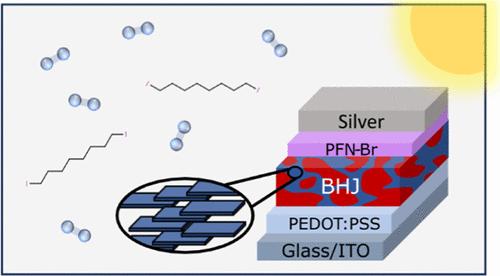探索 1,8-二辛烷对有机光伏器件光稳定性的影响
IF 5.4
3区 材料科学
Q2 CHEMISTRY, PHYSICAL
引用次数: 0
摘要
要实现商业化所需的长期运行寿命,提高有机光伏技术中光收集混合薄膜的光稳定性至关重要。然而,了解导致不稳定性的降解因素非常复杂,薄膜形态、残留溶剂、受体或供体设计等许多变量都会影响光和氧气与共混薄膜的相互作用。在这项研究中,我们展示了由供体聚合物(PBDB-T)和小分子受体(PC71BM 或 ITIC)组成的共混薄膜在使用溶剂添加剂(DIO)处理后如何产生截然不同的薄膜形态、器件性能和光稳定性。我们发现,与 PC71BM 相比,DIO 在基于 ITIC 的薄膜中的保留效率大约高出 10 倍。出乎意料的是,我们发现虽然大量的 DIO 会降低封装 ITIC 器件的光稳定性,但当引入氧气时,DIO 可以提高基于 PBDB-T:ITIC 的电池的使用寿命。在这里,与不添加 DIO 的 ITIC 器件相比,添加 3% 的 DIO 可使 T80 延长一倍,这表明 DIO 引发的形态变化干扰或减少了光氧化反应。本文章由计算机程序翻译,如有差异,请以英文原文为准。

Exploring the Impact of 1,8-Diioodoctane on the Photostability of Organic Photovoltaics
Improving the photostability of the light-harvesting blend film in organic photovoltaics is crucial to achieving long-term operational lifetimes that are required for commercialization. However, understanding the degradation factors which drive instabilities is complex, with many variables such as film morphology, residual solvents, and acceptor or donor design all influencing how light and oxygen interact with the blend film. In this work, we show how blend films comprising a donor polymer (PBDB-T) and small molecule acceptor (PC71BM or ITIC) processed with solvent additive (DIO) yield very different film morphologies, device performance, and photostability. We show that DIO is retained approximately 10 times more effectively in ITIC based films compared to PC71BM. Unexpectedly, we see that while high volumes of DIO reduce photostability for encapsulated ITIC devices, when oxygen is introduced DIO can improve the lifetime of PBDB-T:ITIC based cells. Here, the addition of 3% DIO doubles the T80 compared to ITIC based devices without DIO, suggesting that DIO-induced morphological changes interfere with or reduce photo-oxidative reactions.
求助全文
通过发布文献求助,成功后即可免费获取论文全文。
去求助
来源期刊

ACS Applied Energy Materials
Materials Science-Materials Chemistry
CiteScore
10.30
自引率
6.20%
发文量
1368
期刊介绍:
ACS Applied Energy Materials is an interdisciplinary journal publishing original research covering all aspects of materials, engineering, chemistry, physics and biology relevant to energy conversion and storage. The journal is devoted to reports of new and original experimental and theoretical research of an applied nature that integrate knowledge in the areas of materials, engineering, physics, bioscience, and chemistry into important energy applications.
 求助内容:
求助内容: 应助结果提醒方式:
应助结果提醒方式:


